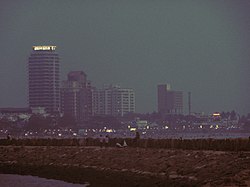Kozhikode
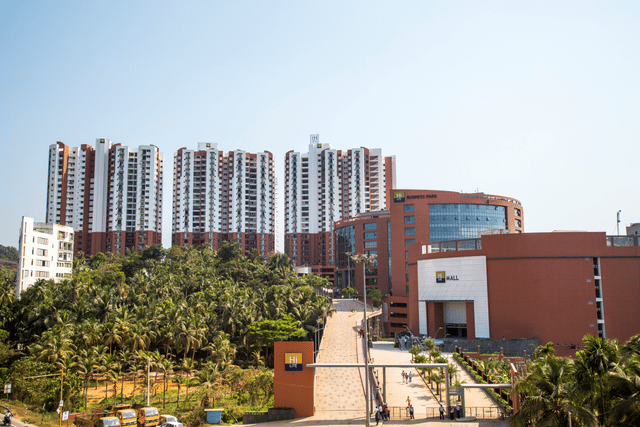
Kozhikode

Kozhikode Calicut | |
|---|---|
Metropolis | |
Clockwise from top: Calicut beach skyline, KSRTC bus stand complex, Calicut mini bypass, Kakkayam Valley,Kozhikode Beach, IIM Kozhikode, Hilite Mall. | |
| Nickname(s): | |
| Coordinates:11°15′N 75°46′E [63] | |
| Country | |
| State | Kerala |
| District | Kozhikode |
| Government | |
| • Type | Mayor–council government |
| • Body | Kozhikode Corporation |
| • Mayor | Thottathil Raveendran[4] |
| • Collector | Sri.Sriram Sambasiva Rao[5] |
| • City Police Commissioner | A.V. George IPS[6] |
| • Member of Parliament | M. K. Raghavan |
| Area | |
| • Metropolis | 177 km2(68 sq mi) |
| • Metro | 518 km2(200 sq mi) |
| Elevation | 1 m (3 ft) |
| Population (2011) | |
| • Metropolis | 608,255 |
| • Density | 3,400/km2(8,900/sq mi) |
| • Metro | 2,030,519 |
| • Municipal corporation | 608,255[9] |
| [11] | |
| Languages | |
| • Official | Malayalam, English |
| Time zone | UTC+5:30 (IST) |
| PIN | 673 xxx |
| Telephone code | 91 (0)495 , 496 |
| Vehicle registration | KL 11, KL 18, KL 56, KL 57, KL 76, KL 77, KLD (Old) |
| Sex ratio | 1.093 ♀/♂[11] |
| Literacy | 96.8%[11] |
| Website | www.kozhikode.nic.in [64] |
Kozhikode ([koːɻikːoːɖ] (listen)), also known as Calicut, is a Tier 2 Metro city in Kerala, India and the headquarters of the Kozhikode district. The Kozhikode metropolitan area is the second largest urban agglomeration in Kerala with a population of 2 million as of 2011.[12] The city lies about 358 km south west of Bangalore, 233 km south of Mangalore and 525 km south west of Chennai.
Kozhikode Calicut | |
|---|---|
Metropolis | |
Clockwise from top: Calicut beach skyline, KSRTC bus stand complex, Calicut mini bypass, Kakkayam Valley,Kozhikode Beach, IIM Kozhikode, Hilite Mall. | |
| Nickname(s): | |
| Coordinates:11°15′N 75°46′E [63] | |
| Country | |
| State | Kerala |
| District | Kozhikode |
| Government | |
| • Type | Mayor–council government |
| • Body | Kozhikode Corporation |
| • Mayor | Thottathil Raveendran[4] |
| • Collector | Sri.Sriram Sambasiva Rao[5] |
| • City Police Commissioner | A.V. George IPS[6] |
| • Member of Parliament | M. K. Raghavan |
| Area | |
| • Metropolis | 177 km2(68 sq mi) |
| • Metro | 518 km2(200 sq mi) |
| Elevation | 1 m (3 ft) |
| Population (2011) | |
| • Metropolis | 608,255 |
| • Density | 3,400/km2(8,900/sq mi) |
| • Metro | 2,030,519 |
| • Municipal corporation | 608,255[9] |
| [11] | |
| Languages | |
| • Official | Malayalam, English |
| Time zone | UTC+5:30 (IST) |
| PIN | 673 xxx |
| Telephone code | 91 (0)495 , 496 |
| Vehicle registration | KL 11, KL 18, KL 56, KL 57, KL 76, KL 77, KLD (Old) |
| Sex ratio | 1.093 ♀/♂[11] |
| Literacy | 96.8%[11] |
| Website | www.kozhikode.nic.in [64] |
Etymology
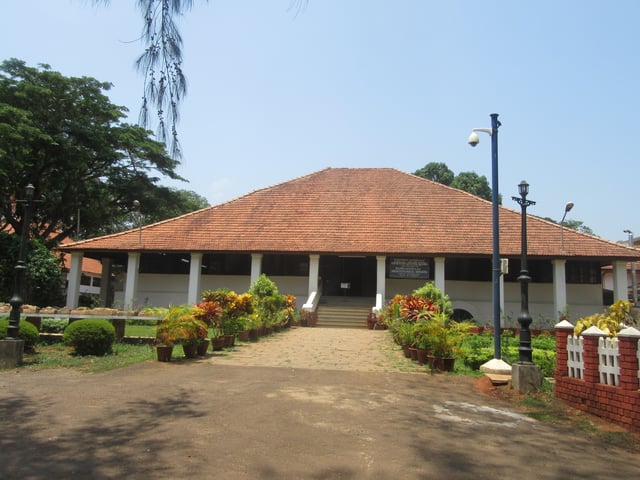
Pazhashi Raja Museum
Although the city's official name is Kozhikode, in English it is sometimes known by its anglicised version, Calicut.[16] The word calico, a fine variety of hand-woven cotton cloth that was exported from the port of Kozhikode, is thought to have been derived from Calicut.[17] It is the historical capital of Kerala as the history dates back to 1498 AD when Vasco da Gama landed in Kappad, near Calicut.[18]
History
During classical antiquity and the Middle Ages, Kozhikode was dubbed the City of Spices for its role as the major trading point of Indian spices.[1] It was the capital of an independent kingdom ruled by the Samoothiris (Zamorins) in the Middle Ages and later of the erstwhile Malabar District under British rule. Arab merchants traded with the region as early as 7th century, and Portuguese explorer Vasco da Gama landed at Kozhikode on 20 May 1498, thus opening a trade route between Europe and Malabar. A Portuguese factory and the fort was intact in Kozhikode for short period (1511–1525, until the Fall of Calicut). The English landed in 1615 (constructing a trading post in 1665), followed by the French (1698) and the Dutch (1752). In 1765, Mysore captured Kozhikode as part of its occupation of the Malabar Coast. Kozhikode, once a famous cotton-weaving centre, gave its name to the Calico cloth.[19]
It was ranked eleventh among Tier-II Indian cities in job creation by a study conducted by ASSOCHAM in 2007.[20] According to data compiled by economics research firm Indicus Analytics in 2009 on residences, earnings and investments, Kozhikode ranked as the second best city in India to reside in.[21]
Early Kozhikode in foreign accounts
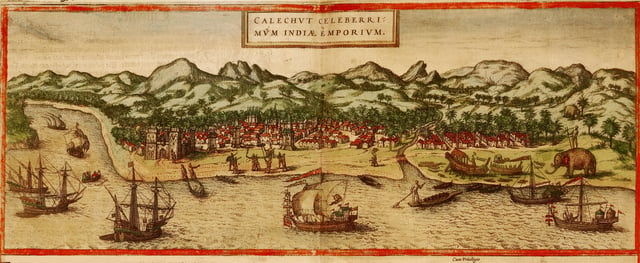
Image of Kozhikode, India from Georg Braun and Frans Hogenberg's atlas Civitates Orbis terrarum, 1572
Accounts of the city and the conditions prevailing then can be gleaned from the chronicles of travellers who visited the port city.
Ibn Battuta (1342–1347), who visited six times, gives the earliest glimpses of life in the city. He describes Kozhikode as "one of the great ports of the district of Malabar" where "merchants of all parts of the world are found". The king of this place, he says, "shaves his chin just as the Haidari Fakeers of Rome do... The greater part of the Muslim merchants of this place are so wealthy that one of them can purchase the whole freightage of such vessels put here and fit out others like them".[22]
Ma Huan (1403 AD), the Chinese sailor part of the Imperial Chinese fleet under Cheng Ho (Zheng He)[23] lauds the city as a great emporium of trade frequented by merchants from around the world. He makes note of the 20 or 30 mosques built to cater to the religious needs of the Muslims, the unique system of calculation by the merchants using their fingers and toes (followed to this day) and the matrilineal system of succession.
Abdur Razzak (1442–43) the ambassador of Persian Emperor Sha-Rohk finds the city harbour perfectly secured and notices precious articles from several maritime countries especially from Abyssinia, Zirbad and Zanzibar.
The Italian Niccolò de' Conti (1445), perhaps the first Christian traveller who noticed Kozhikode, describes the city as abounding in pepper, lac, ginger, a larger kind of cinnamon, myrobalans and zedary. He calls it a noble emporium for all India, with a circumference of eight miles (13 km).
The Russian traveller Athanasius Nikitin or Afanasy Nikitin (1468–74) calls 'Calecut' a port for the whole Indian sea and describes it as having a "big bazaar."
The Samoothiri
Kozhikode and its suburbs formed part of the Polanad kingdom ruled by the Porlatiri.[26] The Eradis of Nediyirippu in Eranad wanted an outlet to the sea, to initiate trade and commerce with the distant lands.[27] and after fighting with the king Polatthiri for 48 years conquered the area around Panniankara. After this, Menokki became the ruler of Polanad and came to terms with the troops and people.[28] After this, the town of Kozhikode was founded close to the palace at Tali.[29] Then, the Eradis shifted their headquarters from Nediyirippu to Kozhikode. The Governor of Ernad built a fort at a place called Velapuram to safeguard his new interests. The fort most likely lent its name to Koyil Kotta the precursor to Kozhikode. Thus the city came into existence sometime in the 13th century CE. The status of Udaiyavar increased and he became known as Swami Nambiyathiri Thirumulpad, and eventually Samuri or Samoothiri. Europeans called him in a corrupt form as Zamorin.
According to K.V. Krishna Iyer, the rise of Kozhikode is at once a cause and a consequence of Samoothiri's ascendancy in Kerala. By the end of the century, Samoothiri was at the zenith of his powers with all princes and chieftains of Kerala north of Kochi acknowledging his suzerainty.[30]
Geography and climate
Geography

View of Kappad beach
The city of Kozhikode is 410 kilometres (255 mi) north of the state capital Thiruvananthapuram. It is located at approximately 11°15′N 75°46′E [65] . It has an elevation of 1 metre (3 ft) along the coast with the city's eastern edges rising to at least 15 metres, with a sandy coastal belt and a lateritic midland. The city has a 15 km (9.3 mi) long shoreline and small hills dot the terrain in the eastern and central regions. To the city's west is the Laccadive Sea and from approximately 60 kilometres (37 mi) to the east rises the Sahyadri Mountains.
The geographical conditions of city area and suburban areas are similar to the other parts of the district falling in coastal and midland zones. The region comprising Kozhikode Corporation and peri-urban blocks belong to the low- and Midlands in the typical classification of land in Kerala as low-, mid- and highlands. Lagoons and backwaters characterise the lowland, which receives runoff from the rivers. The lowland is often subjected to salinity intrusion. The coastal plains exhibit more or less flat, narrow terrain with land forms such as beach ridges, sandbars, and backwater marshes. A few kilometres from the sea to the east, the surface gathers into slopes and clustering hills with numerous valleys in between formed due to floods and sediment transport. The Midlands is represented by hummocky rocky terrain with lateritised denudational hills and intervening valley fills (locally called elas). The 'elas' are fairly wide in the lower reaches of midlands and narrow towards the upper parts of the Midlands.
A number of rivers originating from the Sahyadri run along the outer reaches of the city. These include the Chaliyar puzha, Kallayi Puzha, Korapuzha river, Poonoor puzha (river), and Iravanjhi puzha. Of these, Kallai river that runs through the southern part of the city has been the most important culturally and historically for Kozhikode. The Kallai River has its origin in Cherikkulathur village. It is connected with Chaliyar on the south by a man-made canal. The river passes through Cherukulathur, Kovur, Olavanna, Manava and Kallai before finally joining the sea near Kozhikode. The length of the river is 22 kilometres (14 mi).
The Korapuzha river is formed by the confluence of the Agalapuzha with the Punnurpuzha, and it joins the sea at Elathur. The Agalapuzha is more or less a backwater while the Punnurpuzha originates from Arikkankunni. The total length of the river is 40 kilometres (25 mi). Panurpuzha is a tributary of Korapuzha. It passes through the northern boundary of the study area and joins to the sea. The river is perennial.
Canoly Canal was built in 1848 to connect the Korapuzha river in the north to Kallayi river in the south. It functions as a drain to reduce flooding in the city during the rainy season and as a navigation channel. A system of wetland (mangrove) forests pervades the city from Kallai river to Eranjikkal.
Climate
Kozhikode features a tropical monsoon climate (Köppen climate classification Am). The city has a highly humid tropical climate with high temperatures recorded from March to May. A brief spell of pre-monsoon Mango showers hits the city sometime during April. However, the primary source of rain is the South-west monsoon that sets in the first week of June and continues until September. The city receives significant precipitation from the North-East Monsoon that sets in from the second half of October through November.
The average annual rainfall is 3,266 mm. The weather is milder from December/January until March when the skies are clear and the air is crisp. Winters are seldom cold. The highest temperature recorded was 39.4 °C in March 1975. The lowest was 14 °C recorded on 26 December 1975.
| Climate data for Kozhikode | |||||||||||||
|---|---|---|---|---|---|---|---|---|---|---|---|---|---|
| Month | Jan | Feb | Mar | Apr | May | Jun | Jul | Aug | Sep | Oct | Nov | Dec | Year |
| Record high °C (°F) | 35.8 (96.4) | 36.6 (97.9) | 34.6 (94.3) | 34.4 (93.9) | 34.3 (93.7) | 34.0 (93.2) | 32.1 (89.8) | 30.8 (87.4) | 31.9 (89.4) | 32.7 (90.9) | 33.7 (92.7) | 34.0 (93.2) | 36.6 (97.9) |
| Average high °C (°F) | 31.7 (89.1) | 32.1 (89.8) | 32.8 (91.0) | 33.3 (91.9) | 32.2 (90.0) | 29.5 (85.1) | 28.2 (82.8) | 28.4 (83.1) | 29.5 (85.1) | 30.4 (86.7) | 31.2 (88.2) | 31.5 (88.7) | 30.9 (87.6) |
| Daily mean °C (°F) | 26.8 (80.2) | 27.7 (81.9) | 28.9 (84.0) | 29.6 (85.3) | 29.1 (84.4) | 26.7 (80.1) | 26.0 (78.8) | 25.9 (78.6) | 26.8 (80.2) | 27.3 (81.1) | 27.5 (81.5) | 27.2 (81.0) | 27.5 (81.4) |
| Average low °C (°F) | 22.0 (71.6) | 23.1 (73.6) | 24.8 (76.6) | 25.9 (78.6) | 25.5 (77.9) | 23.9 (75.0) | 23.3 (73.9) | 23.5 (74.3) | 23.9 (75.0) | 23.9 (75.0) | 23.5 (74.3) | 22.4 (72.3) | 23.8 (74.8) |
| Record low °C (°F) | 17.4 (63.3) | 19.0 (66.2) | 21.3 (70.3) | 20.8 (69.4) | 21.5 (70.7) | 21.0 (69.8) | 20.3 (68.5) | 21.2 (70.2) | 21.2 (70.2) | 18.4 (65.1) | 17.8 (64.0) | 18.0 (64.4) | 17.4 (63.3) |
| Average precipitation mm (inches) | 2.7 (0.11) | 3.4 (0.13) | 21.4 (0.84) | 90.2 (3.55) | 310.9 (12.24) | 818.2 (32.21) | 902.5 (35.53) | 447.3 (17.61) | 233.4 (9.19) | 263.5 (10.37) | 136.6 (5.38) | 35.0 (1.38) | 3,284.6 (129.31) |
| Average rainy days | 0.3 | 0.3 | 1.1 | 4.9 | 10.8 | 25.4 | 25.3 | 23.3 | 13.0 | 11.9 | 7.7 | 1.9 | 125.9 |
| Average relative humidity (%) | 70 | 72 | 73 | 74 | 78 | 88 | 90 | 90 | 86 | 82 | 77 | 71 | 79 |
| Source #1: IMD (average high and low, precipitation)[31] | |||||||||||||
| Source #2: NOAA (extremes, mean, humidity, rain days, 1971–1990)[32] | |||||||||||||
Demographics
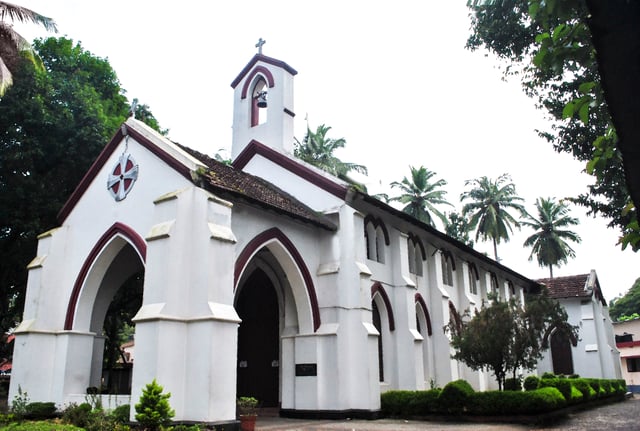
English Church
Total Population under Municipal Corporation limits is 550,440.[9] Males form 47.7% and females 52.3%.
Kozhikode has been a multi-ethnic and multi-religious town since the early medieval period. The Hindus forms the largest religious group, followed by Muslims and Christians.[33] Hindus form the majority at 57.7% of the population with 315807 members.[9] Muslims form 37.6% of the population with 207298 members.[9]
Pre-modern Kozhikode was already teeming with people of several communities and regional groups. Most of these communities continued to follow their traditional occupations and customs till the 20th century.[34] Brahmins, too, lived in the city mostly around the Hindu temples. Regional groups like the Tamil Brahmins, Gujaratis and Marwari Jains became part of the city and lived around their shrines.[35]
The Nairs formed the rulers, warriors and landed gentry of Kozhikode. The Samoothiri had a ten thousand strong Nair bodyguard called the Kozhikkottu pathinaayiram (The 10,000 of Kozhikode) who defended the capital and supported the administration within the city. He had a larger force of 30,000 Nairs in his capacity as the Prince of Eranadu, called the Kozhikkottu Muppatinaayiram (The 30,000 of Kozhikode). The Nairs also formed the members of the suicide squad (chaver). The Thiyyas formed the vaidyars(Physicians), local militia and traders of Kozhikode.
The Muslims of Kozhikode are known as Mappilas, and according to the official Kozhikode website "the great majority of them are Sunnis following the Shafi school of thought.[33] There are some smaller communities among the Muslims such as Dawoodi Bohras of Gujarati origin.[36] Many of the Muslims living in the historic part of the city follow matrilineality and are noted for their piety.[37] Though Christianity is believed to have been introduced in Kerala in 52 CE, the size of community in Malabar (northern Kerala) began to rise only after the arrival of the Portuguese towards the close of the 15th century. A few Christians of Thiruvitankoor and Kochi have lately migrated to the hilly regions of the district and are settled there.[37]
The Tamil Brahmins are primarily settled around the Tali Siva temple. They arrived in Kozhikode as dependants of chieftains, working as cooks, cloth merchants and moneylenders.[38] They have retained their Tamil language and dialects as well as caste rituals. The Gujarati community is settled mostly around the Jain temple in and around the Valliyangadi. They owned a large number of establishments, especially textile and sweet shops. They must have arrived in Kozhikode at least from the beginning of the 14th century. They belong to either the Hindu or the Jain community. A few Marwari families are also found in Kozhikode who was basically moneylenders.
Civic administration
The city is administered by the Kozhikode Corporation, headed by a mayor. For administrative purposes, the city is divided into 75 wards,[39] from which the members of the corporation council are elected for five years. Recently neighbouring suburbs Beypore, Elathur, Cheruvannur and Nallalam were merged within the municipal corporation.
| Kozhikode Municipal Corporation | |
|---|---|
| Mayor | Thottathil Raveendran |
| Deputy Mayor | Meera Darsak |
| Member of Parliament | M.K.Raghvan |
| District Collector | Shri. Seeram Sambasiva Rao IAS |
| Police Commissioner | Shri A V George IPS |
Kozhikode Corporation is the first City Corporation in Kerala after the creation of the state. Established in 1962, Kozhikode Corporation's first mayor was H Manjunatha Rao. Kozhikode corporation has four assembly constituencies – Kozhikode North, Kozhikode South, Beypore and Elathur – all of which are part of Kozhikode.[40]
Corporation Election 2015
Political Performance in Election 2015
| S.No. | Party Name | Party symbol | Number of Corporators |
|---|---|---|---|
| 01 | LDF | 47 | |
| 02 | UDF | 21 | |
| 03 | BJP | 07 | |
| 04 | Independents |  | 0 |
Initiatives by District Administration
Operation Sulaimani : Providing food with dignity for those who cannot afford a meal through contributions from the public.
Project 4 N : Maintenance of roads through public participation.
Savari Giri Giri : To enable students to travel in buses with dignity.
Compassionate Kozhikode:[41] The brand name for plethora of initiatives launched by the District Administration in partnership with civil society, Government agencies and citizens, who volunteer to make Kozhikode an authentic and inspirational destination for them to live and invite others to visit and experience it. It is the brainchild of former District Collector Prasanth N. (IAS).
Law and order
The Kozhikode City Police is headed by a commissioner, an Indian Police Service (IPS) officer. The city is divided into six zones each under a circle officer. Apart from regular law and order, the city police comprise the traffic police, bomb squad, dog squad, fingerprint bureau, women's cell, juvenile wing, narcotics cell, riot force, armed reserve camps, district crime records bureau and a women's station.[42] It operates 16 police stations functioning under the Home Ministry of Government of Kerala.
Transport
Road
The city has a reasonably well-developed transport infrastructure. A large number of buses, predominantly run by individual owners, ply on the major routes within the city and to nearby locations. City buses are painted green. Kerala State Road Transport Corporation (KSRTC) runs regular services to many destinations in the state and to the neighbouring states. The city has three bus stands. All private buses to the suburban and nearby towns ply from the Palayam Bus Stand. Private buses to adjoining districts start from the Mofussil Bus Stand (one of the largest bus stand in Kerala) on Indira Gandhi Road (Mavoor Road). Buses operated by the KSRTC drive from the KSRTC bus stand on Indira Gandhi Road. KSRTC Bus Stand Kozhikode is the biggest bus stand in Kerala having a size of 36,036.47 meter square.[43] There are also KSRTC depots in Thamarassery, Thottilpalam, Thiruvambady and Vatakara in the district.
There are two routes available to Bangalore. One is Kozhikode–Gundlupet–Mysore–Bangalore; this road is most preferred one but is very busy. Another route, less used, is Kozhikode–Gundlupet–Chamarajanagar–Kollegal–Bangalore.
Private tour operators maintain regular luxury bus services to Mumbai, Bangalore, Coimbatore, Chennai, Vellore, Ernakulam, Trivandrum, Ooty etc. and mainly operate from the Palayam area. These are usually night services.
National highways
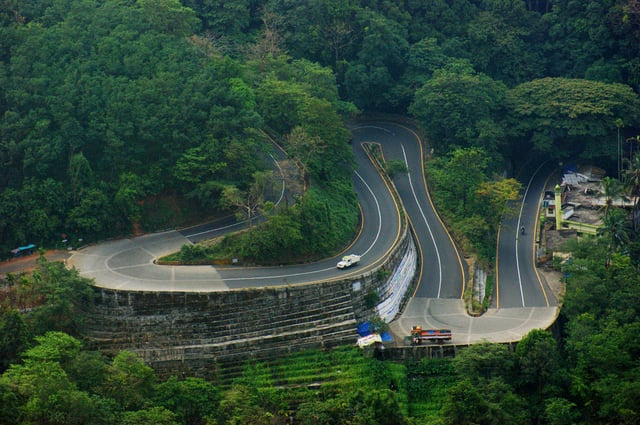
Thamarassery Churam is one of the popular tourist destinations in Kozhikode

Volvo 8400 at Calicut Bus Terminal
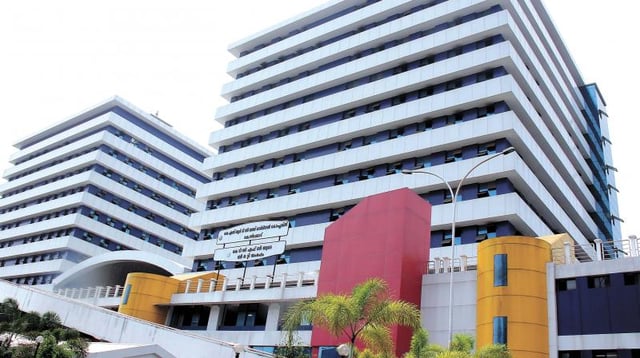
KSRTC bus terminal-cum-shopping complex in Kozhikode
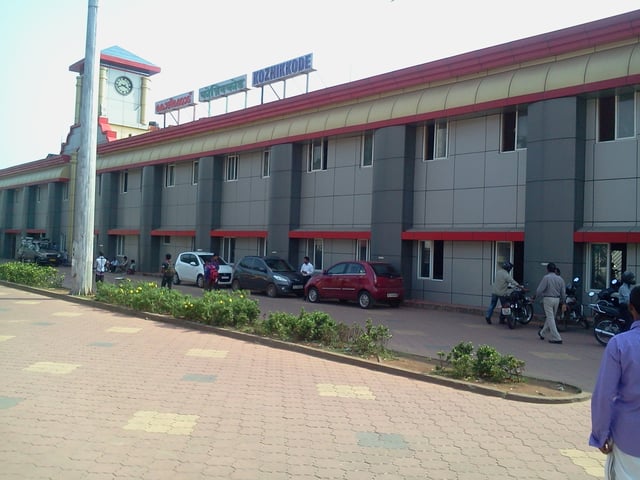
Kozhikode Railway Station is one of the busiest railway stations in South India

Calicut International Airport
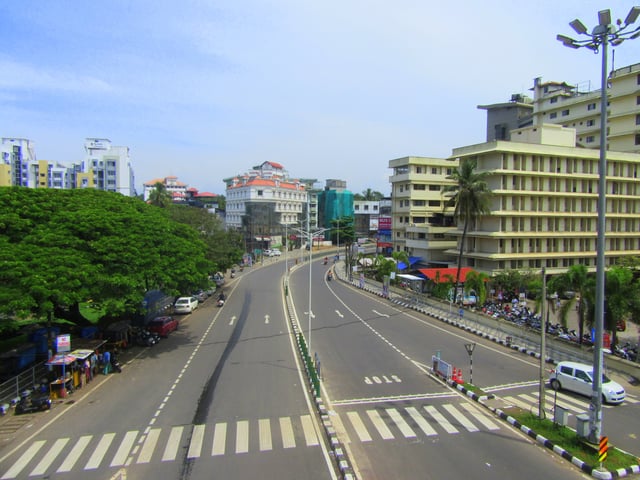
Calicut Mini Bypass.
National Highway 66 connects Kozhikode to Mumbai via Mangaluru, Udupi and Goa to the north and Kochi and Kanyakumari near Thiruvananthapuram to the south along the west coast of India. This highway connects the city with the other important towns like, Uppala, Kasaragod, Kanhangad, Kannur, Thalassery, Mahe, Vadakara, Koyilandy, Vengalam,[44] Ramanattukara, Kottakkal, Kuttippuram, Ponnani, (Guruvayoor)Chavakkad, Kodungallur, North Paravur, Edapally and proceed to Alappuzha, Thiruvananthapuram and terminate at the southern tip of India, Kanyakumari.
National Highway 966 connects Kozhikode to Coimbatore through Malappuram and Palakkad. It covers a distance of 125 kilometres (78 mi). At Ramanattukara, a suburb of Kozhikode, it joins NH 66. It passes through towns like Kondotty, Perinthalmanna, and Mannarkkad and Malappuram city. This stretch connects the city and Calicut International Airport.
State Highways
SH 29 passes through the city. It connects NH 212, Malabar Christian College, civil station, Kunnamangalam and Padanilam, Thamarassery, Chellot, Chitragiri and Road to Gudallor from Kerala border.
SH 54 is connecting city and Kalpetta. The highway is 99.0 kilometres (61.5 mi) long. The highway passes through Pavangad, Kozhikode, Ulliyeri, Perambra, Poozhithodu, Peruvannamuzhi and Padinjarethara. SH 68 starts from Kappad and ends in Adivaram. The highway is 68.11 kilometres (42.32 mi) long.
SH 34 starts from Koyilandy and ends in Edavanna which is 44.0 km long. This highway passes through Koyilandi, Ulliyeri, Balussery, Thamarassery, Omassery, Mukkam.
Rail
The history of railways in Malabar dates to 1861 when the first tracks were laid between Tirur and Beypore.[45] Kozhikode railway station is the only A1 railway station in Palakkad railway division; it is in the Shoranur-Mangalore section. Today, Kozhikode is connected by rail to cities like Thiruvananthapuram, Kochi, Thrissur, Kollam, Tirunelveli, Palakkad, Coimbatore, Katpadi, Vellore, Hyderabad, Chennai, Bangalore, Kannur, Mangalore, Mumbai, New Delhi, Vijayawada and Visakhapatnam.
Air
Calicut International Airport is 26 kilometres (16 mi) from the city at Karipur. Domestic services are operated to major Indian cities. There are international flights to the Middle Eastern air hubs like Dubai, Abu Dhabi, Salalah, Muscat, Dammam, Riyadh, Sharjah, Bahrain, Doha and to domestic hubs Chennai, Hyderabad, Bangalore, Mumbai and New Delhi.
Economy
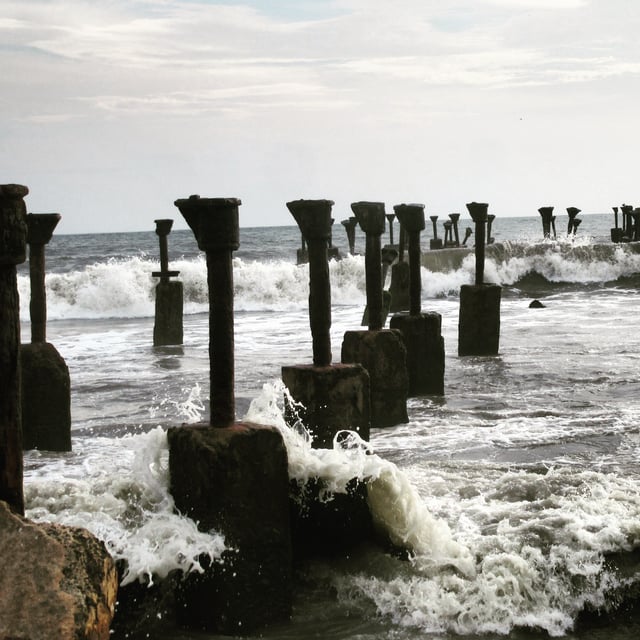
Broken bridge at Calicut beach
Calicut is one of the biggest economic hub in Kerala. Service sector dominates the economy followed by industries. Cyberpark, is a Government of Kerala organisation plan to build, operate and manage IT parks for the promotion and development of investment in IT and ITES industries in the Malabar region of Kerala. It would be the third IT hub in the state of Kerala. The two IT parks might create a total 100,000 direct job opportunities. The first project is the development of Cyberpark hub in Kozhikode with its spokes at Kannur and Kazargode IT parks.[46][47] Other planned projects include the Birla IT park (at Mavoor) and Malaysian satellite city (at Kinaloor) where KINFRA has plans to set up a 400-acre (1.6 km2) industrial park. In 2012, Kozhikode was given the tag of "City of Sculptures" (Shilpa Nagaram) because of the architectural sculptures around the city.[48][49]
Shopping
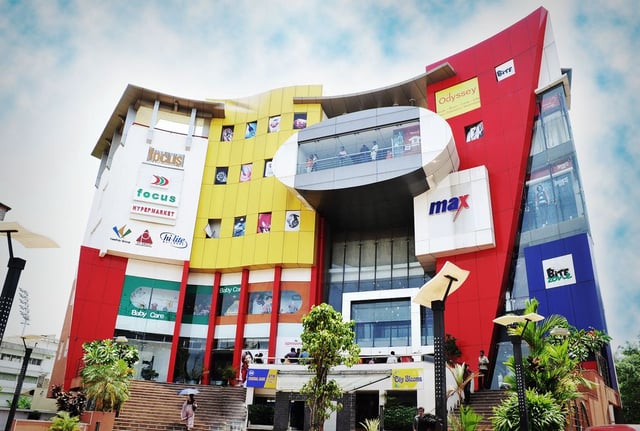
The Focus Mall, the first shopping mall of its kind in the State
The city has a strong mercantile aspect. The main area of business was once Valiyangadi (Big Bazaar) near the railway station. As time progressed, it shifted to other parts of the city.
These days, the commercial heart has moved to Mittai Theruvu (Sweetmeat Street or S. M. Street), a long street crammed with shops that sell everything from saris to cosmetics. It also houses restaurants and sweetmeat shops. Today, the city has multiple shopping malls. Focus Mall, HiLITE Mall (the second largest mall in Kerala)[50] Address Mall and RP Mall are a few among them.[51]
Music
In addition to the Malabar Mahotsavam, the annual cultural fest of Kozhikode,[52] every year since 1981 the Tyagaraja Aradhana Trust has been conducting a five-day music festival in honour of Tyagaraja. The festival is complete with the Uncchavritti, rendering of Divyanama kritis, Pancharatna Kritis, concerts by professional artistes and students of music from morning to late in the evening.[53]
Kozhikode has a tradition of Ghazal and Hindustani music appreciation. There are many Malayalam Ghazals. The late film director and play back singer M. S. Baburaj, from Kozhikode was influenced by Ghazal and Hindustani.[54]
Media
Radio
The Kozhikode radio station of All India Radio has two transmitters: Kozhikode AM (100 kilowatts) and Kozhikode FM [Vividh Bharathi] (10 kilowatts). Private FM radio stations are Radio Mango 91.9 operated by Malayala Manorama Co. Ltd. Radio Mirchi operated by Entertainment Network India Ltd. and Club FM 104.8 operated by Mathrubhumi group and Red FM 93.5 of the SUN Network. AIR FM radio stations are Kozhikode – 103.6 MHz; AIR MW radio station is Kozhikode – 684 kHz.
Television
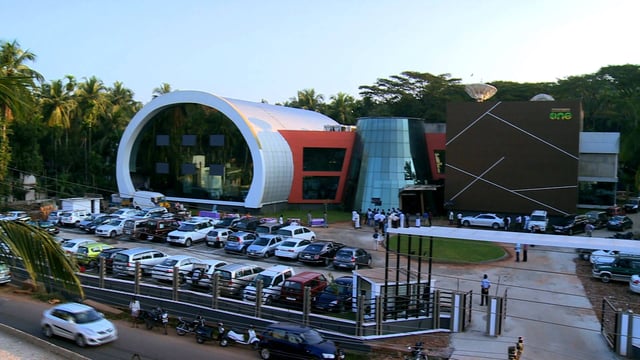
MediaOne TV Headquarters And Studio
A television transmitter has been functioning in Kozhikode since 3 July 1984, relaying programmes from Delhi and Thiruvananthapuram Doordarshan. Doordarshan has its broadcasting centre in Kozhikode at Medical College. The Malayalam channels based on Kozhikode are the Shalom Television, Darshana TV and Media One TV. All major channels in Malayalam viz. Manorama News, Asianet, Surya TV, Kairali TV, Amrita TV, Jeevan TV, Indiavision and Jaihind have their studios and news bureaus in the city.
Satellite television services are available through DD Direct+, Dish TV, Sun Direct DTH and Tata Sky. Asianet Digital TV is popularly known as ACV telecasts daily city news. Spidernet is another local channel. Other local operators include KCL and Citinet.
The Calicut Press Club came into existence in 1970. It is the nerve centre of all media activities, both print and electronic. Begun with around 70 members in the roll, this Press Club, became a prestigious and alert media centre in the state with a present membership of over 280.[55]
Education

National Institute of Technology Calicut
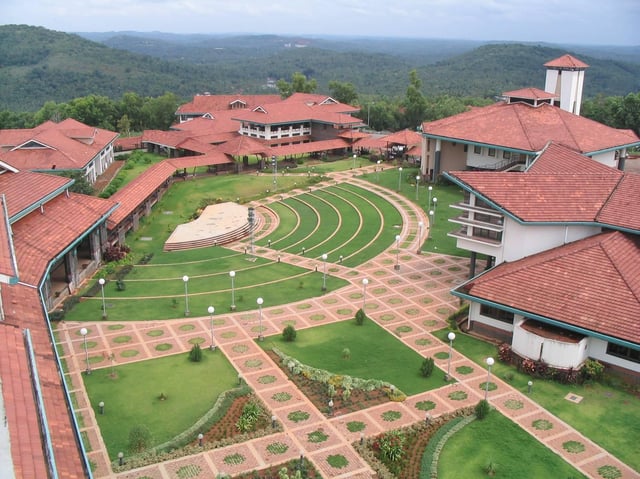
Indian Institute of Management Kozhikode
There are 1,237 schools in Kozhikode district including 191 highschools.[56]
Kozhikode is home to two premier educational institutions of national importance: the Indian Institute of Management Kozhikode (IIMK), and the National Institute of Technology, Calicut (NITC). Other institutions include National Institute for Research and Development in Defence Shipbuilding (NIRDESH),[57] Indian Institute of Spices Research (IISR),[58] and National Institute of Electronics and Information Technology (NIELIT) are also based in Calicut.[59]
The University of Calicut is the largest university in Kerala and is located in Thenjipalam, about 24 kilometres (15 mi) south of Calicut. This university was established in 1968 and was the second university set up in Kerala. Most of the colleges offering tertiary education in the region are affiliated to this university.[60] The Calicut Medical College was established in 1957 as the second medical college in Kerala. Since then, the institution has grown into a premier centre of medical education in the state. Presently it is the largest medical institute in the state with a yearly intake of 250 candidates for the undergraduate programme.
In 1877, a school for young Rajas was started in Kozhikode. This was later thrown open to all caste Hindu boys. In 1879, it was affiliated to the University of Madras as a second-grade college and with this, collegiate education in the district received a fillip. Secondary education recorded appreciable progress since 1915. The erstwhile Malabar district, of which the present Kozhikode district formed a part, holds a high rank among the districts of Madras Presidency in secondary education.[61]
Location
See also
History of Kozhikode
Kozhikode district
Kozhikode Beach
Kozhikode East
Kozhikode North
Kozhikode South
Airport Road, Kozhikode
List of people from Kozhikode
